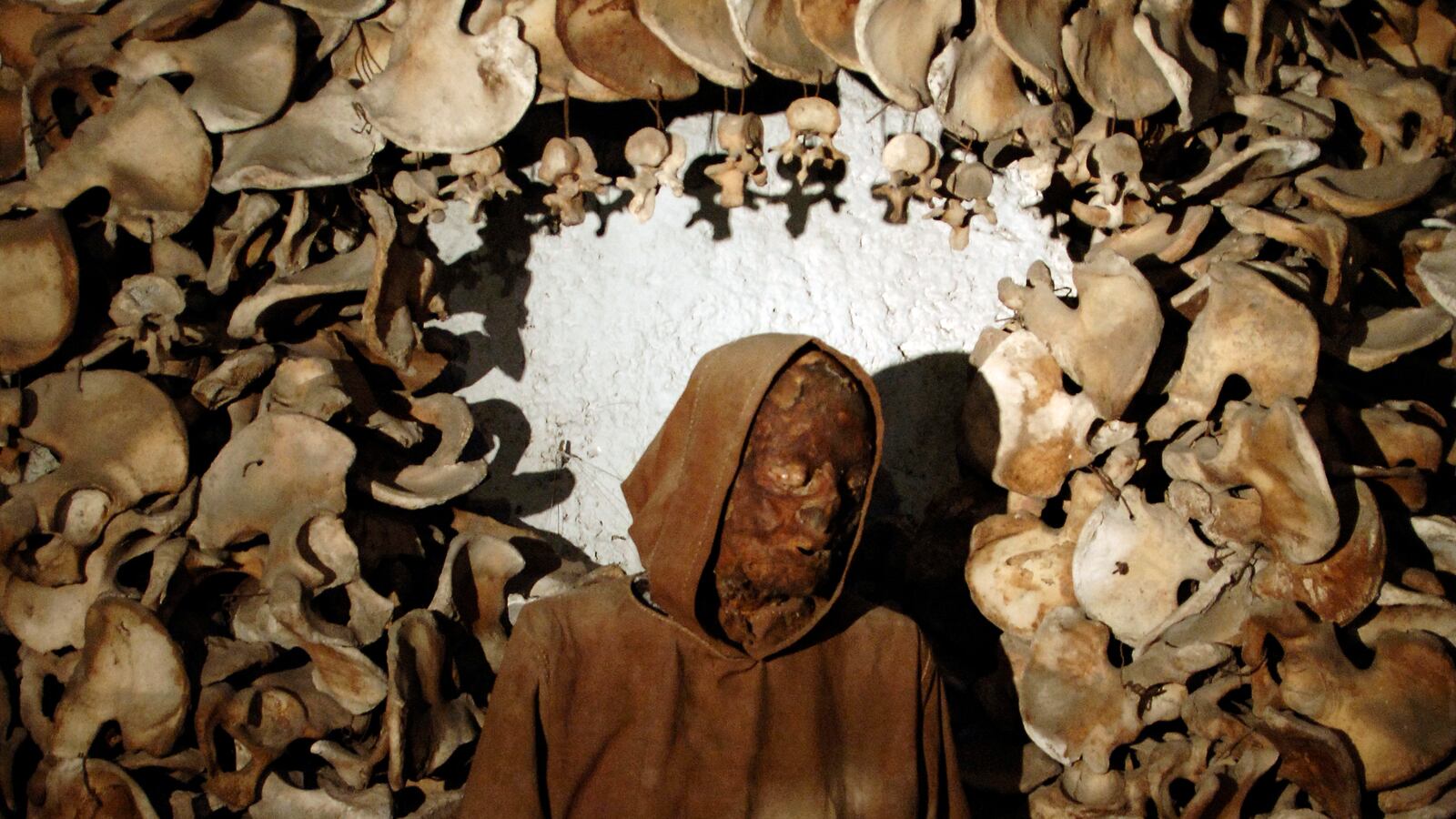Rome is home to hundreds of secret crypts and hidden reliquaries where the faithful pray to bits of bones and vials of blood, but you don’t have to be a devout Catholic to appreciate this underworld excursion into the hidden eternal city. Here are some of our favorite holy hotspots.
Santi Vincenzo e Anastasio a Trevi (Trevi Church of St Vincent and Anastasius)

Santi Vincenzo e Anastasio a Trevi
AlamyPiazza Fontana Trevi
This tiny church on the popular Trevi Fountain square rarely gets noticed what with all the coin tossing going on across the cobblestones. But it is designated as a “pontifical parish” which means it isn’t important enough for the burial of the whole bodies of popes, but was instead good enough for their internal organs, namely their hearts. Because embalming of popes was strictly forbidden, many of their internal organs and sections of their hearts, known as praecordia in Latin, were removed after death to stop the decomposition process while they lied in state between death and burial. Those hearts were put in jars and rather than being thrown away, they were brought to this little church where they remain today in elaborate urns. A full list of the 22 popes whose hearts are here is carved in a marble plaque beside the altar. The practice ended after the death of Pope Leo in 1904.
Open most afternoons from 4 - 6:30pm.
Arciconfraternita Santa Maria dell'Orazione e Morte ( St. Mary of Eulogies and the Dead)

Via Giulia 262
This tiny church exudes images of death, from the winged skulls carved into the facade to the chandelier made of human spines in the basement crypt. The church was built in the 1500s over a cemetery where a group of devout Catholics buried abandoned corpses found around the city. It quickly became the meeting point for a secret society of widows and devout spinsters who still come here to pray for the lost souls in purgatory among the shelves of skulls and piles of human bones sorted by limb and body part. The church isn’t always open from the front so you should also try the back along the Tiber River, but either way, once you get in, you have to tip the nun three euro to get her to open the crypt and walk you down the short flight of stairs where she will leave you alone among the bones to contemplate mortality. The church and creepy crypt are undergoing a massive renovation and much-needed cleaning of layers of votive candle wax spilled on the marble floors and are set to reopen this summer.
Weekdays 10am to 12:15/4 - 6:30pm. Weekends 10am - 12:30/4-7pm.
Santa Maria della Concezione dei Cappuccini (Our Lady of the Conception of the Capuchins)

Santa Maria della Concezione dei Cappuccini
AlamyVia Vittorio Veneto, 27
When the Cappuccini monks, namesake for the creamy coffee drink, were forced to move to a new Roman friary in 1631, the papal powers told them to also take their dead with them, even though the new digs offered little in the way of adequate burial space. So the enterprising monks decided to debone their brethren and decorate their new church crypt with the remains, including skulls, fingers, femurs and pelvises. The decorations proved so elaborate and oddly beautiful, they continued dissecting their dead for more than 300 years, and now the bones of more than 4,000 friars who died between 1528 and 1870 adorn the lower church. There are full walls filled with staring skulls and floral ceiling depictions made from delicate finger and toe bones. There is even a special crypt made entirely of pelvises.
Open daily from 9am - 7pm.
Santa Maria in Cosmedin (St. Mary in Cosmedin)

Santa Maria in Cosmedin
AlamyPiazza della Bocca della Verità, 1
This fourth century church built over a pagan temple is perhaps best known for its giant Bocca della Verità or Mouth of Truth that has adorned the portico since 1632. Visitors line up for hours for a photo with their hand in the marble mask’s mouth which is said to bite the hand of anyone who is untruthful (though such a chomp is yet to be documented in its many centuries of existence). But the real hidden gem of this medieval church is the skull of St. Valentine kept in a flower-filled glass-encased reliquary in an enclave about midway down the left aisle of the quaint church. Visitors are asked to donate 50 euro cents to light a candle to pray to the skull for luck in love, but most just snap selfies and move on. On Valentine’s Day, the reliquary is backlit and put on display on the main altar of the church and adorned with roses left by lovers whose prayers were answered.
Open daily from 9:30 - 5:50pm.
San Giovanni in Laterano (St. John in Lateran)

San Giovanni in Laterano
AlamyPiazza di S. Giovanni in Laterano, 4
For many centuries, saintly bits and holy body parts, including Jesus’ umbilical cord and foreskin, were kept in a locked room in Rome’s Sancta Sanctorum which also houses the marble staircase that Jesus walked before he was sentenced to crucifixion in the palace of Pontius Pilate in Jerusalem. Devout pilgrims are invited to climb the stairs on their knees to prove the depths of their faith (and often, the sanctity of their joints). As for the relics, the umbilical cord is now in France and the prepuce was stolen, but the rest, including the heads of saints Peter and Paul, are now in the relic room in the basilica of San Giovanni Laterano across the busy street from the holy staircase. There, relic hunters will also find a chunk of wood from the Last Supper table and a slab of the communion altar used by the first pope St. Peter in the presbytery. And don’t miss the statutes of the twelve apostles, all depicted with their forms of execution including St. Bartholomew holding the skin that was flayed from his body.
Church open daily from 7:30am - 6:30 pm, relic room daily from 8am - noon/4pm - 6pm.
Santa Croce in Gerusalemme (Holy Cross of Jerusalem)

Santa Croce in Gerusalemme
AlamyPiazza Santa Croce in Gerusalemme
Just down the road from San Giovanni in Laterano is the towering facade of Santa Croce in Gerusalemme which houses the most important collection of relics from Jesus’ crucifixion. The relics are all in a single glass case in the dedicated chapel at the end of the left aisle of the main basilica and include two thorns from the Crown of Thornsalong with the sign that hung over his cross with the words Titulus Crucis. There are also three pieces of the actual cross he was hung on and, as a bonus, the doubting finger that belonged to the Apostle Thomas, AKA Doubting Thomas, who would not believe Jesus rose from the dead without seeing his actual crucifixion wounds.This chapel also has a statue to Saint Helena where those seeking divine intervention leave photos and notes pleading for help at her feet.
Open Mon-Saturday 7am - 12:45pm/3:30 - 7:30pm, Sundays and holidays 7:30 -12:45/3:30 - 7:30pm (Closed during masses, funerals and weddings.)
San Paolo Fuori Le Mura (St. Paul’s Outside the Walls)

San Paolo Fuori Le Mura
AlamyPiazzale San Paolo 1
Built on the spot where St. Paul was executed and buried, this important papal church in Rome is a favorite for relic hunters who will find the largest collection of saintly body bits anywhere in the eternal city, from vials of blood to the fingernails and skull fragments of popes and saints. The Chapel of Relics is just beyond the massive basilica’s picture gallery and also houses an impressive selection of non-human relics, including the nine-link chain used to imprison St. Paul by linking him to his prison guard, and a piece of wood from the cross on which Jesus was crucified. A ticket to the relic chapel also allows visitors to visit the secret cloister with its impressive twisted columns and lush sculpted gardens.
Open daily 7:30 am - 6:30pm.
Chiesa del Sacro Cuore del Suffragio (Church of the Sacred Heart of the Suffrage)

Chiesa del Sacro Cuore del Suffragio
AlamyLungotevere Prati, 12
When a back chapel of this neo gothic church burned in 1897, the French parish priest was convinced that he saw the face of a soul trapped in purgatory in the burnt wood of the flames. His belief was so strong that he commissioned the new chapel as the Museum of the Holy Souls in Purgatory which now houses hundreds of examples of signs of lost souls waiting to ascend into heaven. Among the museum’s curious exhibits are clear examples of prints of singed hands on bibles and parchment paper and even the nightcap of a man whose wife is said to have reached out to him as he slept. There are also burnt vestments worn by priests who say they were visited by the dead and many other items displayed as pretty convincing proof of those trying to reach the living to pray for them to get out of Purgatory.November 2, designated as All Soul’s Day, is a special day in this museum and church, where the truly devout come to pray to help free those trapped in the middle ground between hell and heaven.
Open daily 7:30 - 11am/4:30-7:30pm.






